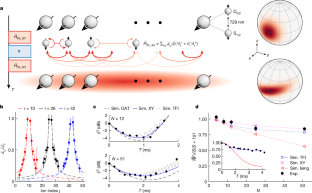2023-09-25 米国国立標準技術研究所(NIST)
◆この方法は、スピンスクィージングと呼ばれ、原子をもつれさせ、測定の信号を強化します。この技術は、量子センサー、原子時計、物理学の研究に革命をもたらす可能性があります。
<関連情報>
- https://www.nist.gov/news-events/news/2023/09/new-spin-squeezing-techniques-let-atoms-work-together-better-quantum
- https://www.nature.com/articles/s41586-023-06472-z
- https://www.nature.com/articles/s41586-023-06360-6
有限距離相互作用による光遷移の量子計測 Quantum-enhanced sensing on optical transitions through finite-range interactions
Johannes Franke,Sean R. Muleady,Raphael Kaubruegger,Florian Kranzl,Rainer Blatt,Ana Maria Rey,Manoj K. Joshi & Christian F. Roos
Nature Published:30 August 2023
DOI:https://doi.org/10.1038/s41586-023-06472-z

Abstract
The control over quantum states in atomic systems has led to the most precise optical atomic clocks so far1,2,3. Their sensitivity is bounded at present by the standard quantum limit, a fundamental floor set by quantum mechanics for uncorrelated particles, which can—nevertheless—be overcome when operated with entangled particles. Yet demonstrating a quantum advantage in real-world sensors is extremely challenging. Here we illustrate a pathway for harnessing large-scale entanglement in an optical transition using 1D chains of up to 51 ions with interactions that decay as a power-law function of the ion separation. We show that our sensor can emulate many features of the one-axis-twisting (OAT) model, an iconic, fully connected model known to generate scalable squeezing4 and Greenberger–Horne–Zeilinger-like states5,6,7,8. The collective nature of the state manifests itself in the preservation of the total transverse magnetization, the reduced growth of the structure factor, that is, spin-wave excitations (SWE), at finite momenta, the generation of spin squeezing comparable with OAT (a Wineland parameter9,10 of −3.9 ± 0.3 dB for only N = 12 ions) and the development of non-Gaussian states in the form of multi-headed cat states in the Q-distribution. We demonstrate the metrological utility of the states in a Ramsey-type interferometer, in which we reduce the measurement uncertainty by −3.2 ± 0.5 dB below the standard quantum limit for N = 51 ions.
光クロックでリュードベリ相互作用によるスピンスクイーズを実現 Realizing spin squeezing with Rydberg interactions in an optical clock
William J. Eckner,Nelson Darkwah Oppong,Alec Cao,Aaron W. Young,William R. Milner,John M. Robinson,Jun Ye & Adam M. Kaufman
Nature Published:30 August 2023
DOI:https://doi.org/10.1038/s41586-023-06360-6

Abstract
Neutral-atom arrays trapped in optical potentials are a powerful platform for studying quantum physics, combining precise single-particle control and detection with a range of tunable entangling interactions1,2,3. For example, these capabilities have been leveraged for state-of-the-art frequency metrology4,5 as well as microscopic studies of entangled many-particle states6,7,8,9,10,11. Here we combine these applications to realize spin squeezing—a widely studied operation for producing metrologically useful entanglement—in an optical atomic clock based on a programmable array of interacting optical qubits. In this demonstration of Rydberg-mediated squeezing with a neutral-atom optical clock, we generate states that have almost four decibels of metrological gain. In addition, we perform a synchronous frequency comparison between independent squeezed states and observe a fractional-frequency stability of 1.087(1) × 10−15 at one-second averaging time, which is 1.94(1) decibels below the standard quantum limit and reaches a fractional precision at the 10−17 level during a half-hour measurement. We further leverage the programmable control afforded by optical tweezer arrays to apply local phase shifts to explore spin squeezing in measurements that operate beyond the relative coherence time with the optical local oscillator. The realization of this spin-squeezing protocol in a programmable atom-array clock will enable a wide range of quantum-information-inspired techniques for optimal phase estimation and Heisenberg-limited optical atomic clocks12,13,14,15,16.



